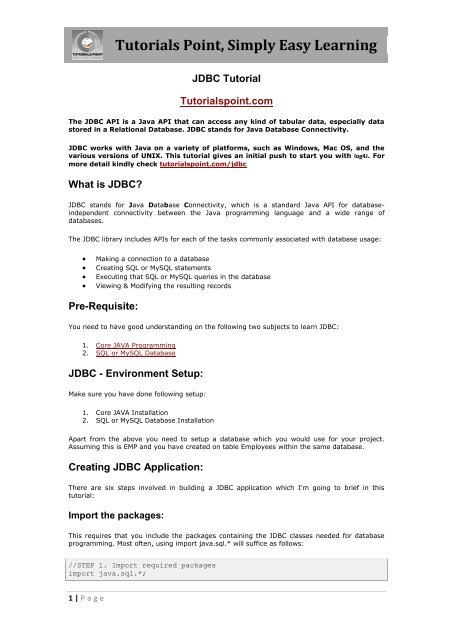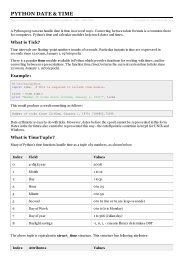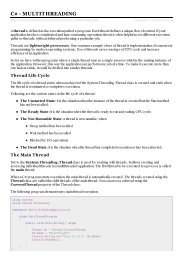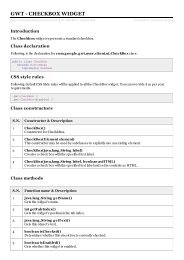Tutorials Point, Simply Easy Learning
Tutorials Point, Simply Easy Learning
Tutorials Point, Simply Easy Learning
Create successful ePaper yourself
Turn your PDF publications into a flip-book with our unique Google optimized e-Paper software.
<strong>Tutorials</strong> <strong>Point</strong>, <strong>Simply</strong> <strong>Easy</strong> <strong>Learning</strong><br />
JDBC Tutorial<br />
<strong>Tutorials</strong>point.com<br />
The JDBC API is a Java API that can access any kind of tabular data, especially data<br />
stored in a Relational Database. JDBC stands for Java Database Connectivity.<br />
JDBC works with Java on a variety of platforms, such as Windows, Mac OS, and the<br />
various versions of UNIX. This tutorial gives an initial push to start you with log4J. For<br />
more detail kindly check tutorialspoint.com/jdbc<br />
What is JDBC?<br />
JDBC stands for Java Database Connectivity, which is a standard Java API for databaseindependent<br />
connectivity between the Java programming language and a wide range of<br />
databases.<br />
The JDBC library includes APIs for each of the tasks commonly associated with database usage:<br />
<br />
<br />
<br />
<br />
Making a connection to a database<br />
Creating SQL or MySQL statements<br />
Executing that SQL or MySQL queries in the database<br />
Viewing & Modifying the resulting records<br />
Pre-Requisite:<br />
You need to have good understanding on the following two subjects to learn JDBC:<br />
1. Core JAVA Programming<br />
2. SQL or MySQL Database<br />
JDBC - Environment Setup:<br />
Make sure you have done following setup:<br />
1. Core JAVA Installation<br />
2. SQL or MySQL Database Installation<br />
Apart from the above you need to setup a database which you would use for your project.<br />
Assuming this is EMP and you have created on table Employees within the same database.<br />
Creating JDBC Application:<br />
There are six steps involved in building a JDBC application which I'm going to brief in this<br />
tutorial:<br />
Import the packages:<br />
This requires that you include the packages containing the JDBC classes needed for database<br />
programming. Most often, using import java.sql.* will suffice as follows:<br />
//STEP 1. Import required packages<br />
import java.sql.*;<br />
1 | P a g e
<strong>Tutorials</strong> <strong>Point</strong>, <strong>Simply</strong> <strong>Easy</strong> <strong>Learning</strong><br />
Register the JDBC driver:<br />
This requires that you initialize a driver so you can open a communications channel with the<br />
database. Following is the code snippet to achieve this:<br />
//STEP 2: Register JDBC driver<br />
Class.forName("com.mysql.jdbc.Driver");<br />
Open a connection:<br />
This requires using the DriverManager.getConnection() method to create a Connection object,<br />
which represents a physical connection with the database as follows:<br />
//STEP 3: Open a connection<br />
// Database credentials<br />
static final String USER = "username";<br />
static final String PASS = "password";<br />
System.out.println("Connecting to database...");<br />
conn = DriverManager.getConnection(DB_URL,USER,PASS);<br />
Execute a query:<br />
This requires using an object of type Statement or PreparedStatement for building and<br />
submitting an SQL statement to the database as follows:<br />
//STEP 4: Execute a query<br />
System.out.println("Creating statement...");<br />
stmt = conn.createStatement();<br />
String sql;<br />
sql = "SELECT id, first, last, age FROM Employees";<br />
ResultSet rs = stmt.executeQuery(sql);<br />
If there is an SQL UPDATE,INSERT or DELETE statement required, then following code snippet<br />
would be required:<br />
//STEP 4: Execute a query<br />
System.out.println("Creating statement...");<br />
stmt = conn.createStatement();<br />
String sql;<br />
sql = "DELETE FROM Employees";<br />
ResultSet rs = stmt.executeUpdate(sql);<br />
Extract data from result set:<br />
This step is required in case you are fetching data from the database. You can use the<br />
appropriate ResultSet.getXXX() method to retrieve the data from the result set as follows:<br />
//STEP 5: Extract data from result set<br />
while(rs.next()){<br />
//Retrieve by column name<br />
int id = rs.getInt("id");<br />
int age = rs.getInt("age");<br />
String first = rs.getString("first");<br />
String last = rs.getString("last");<br />
2 | P a g e
<strong>Tutorials</strong> <strong>Point</strong>, <strong>Simply</strong> <strong>Easy</strong> <strong>Learning</strong><br />
}<br />
//Display values<br />
System.out.print("ID: " + id);<br />
System.out.print(", Age: " + age);<br />
System.out.print(", First: " + first);<br />
System.out.println(", Last: " + last);<br />
Clean up the environment:<br />
You should explicitly close all database resources versus relying on the JVM's garbage collection<br />
as follows:<br />
//STEP 6: Clean-up environment<br />
rs.close();<br />
stmt.close();<br />
conn.close();<br />
JDBC Program:<br />
Based on the above steps, we can have following consolidated sample code which we can use as<br />
a template while writing our JDBC code:<br />
This sample code has been written based on the environment and database setup done in<br />
Environment chapter.<br />
//STEP 1. Import required packages<br />
import java.sql.*;<br />
public class FirstExample {<br />
// JDBC driver name and database URL<br />
static final String JDBC_DRIVER = "com.mysql.jdbc.Driver";<br />
static final String DB_URL = "jdbc:mysql://localhost/EMP";<br />
// Database credentials<br />
static final String USER = "username";<br />
static final String PASS = "password";<br />
public static void main(String[] args) {<br />
Connection conn = null;<br />
Statement stmt = null;<br />
try{<br />
//STEP 2: Register JDBC driver<br />
Class.forName("com.mysql.jdbc.Driver");<br />
//STEP 3: Open a connection<br />
System.out.println("Connecting to database...");<br />
conn = DriverManager.getConnection(DB_URL,USER,PASS);<br />
//STEP 4: Execute a query<br />
System.out.println("Creating statement...");<br />
stmt = conn.createStatement();<br />
String sql;<br />
sql = "SELECT id, first, last, age FROM Employees";<br />
ResultSet rs = stmt.executeQuery(sql);<br />
//STEP 5: Extract data from result set<br />
while(rs.next()){<br />
//Retrieve by column name<br />
3 | P a g e
<strong>Tutorials</strong> <strong>Point</strong>, <strong>Simply</strong> <strong>Easy</strong> <strong>Learning</strong><br />
int id = rs.getInt("id");<br />
int age = rs.getInt("age");<br />
String first = rs.getString("first");<br />
String last = rs.getString("last");<br />
//Display values<br />
System.out.print("ID: " + id);<br />
System.out.print(", Age: " + age);<br />
System.out.print(", First: " + first);<br />
System.out.println(", Last: " + last);<br />
}<br />
//STEP 6: Clean-up environment<br />
rs.close();<br />
stmt.close();<br />
conn.close();<br />
}catch(SQLException se){<br />
//Handle errors for JDBC<br />
se.printStackTrace();<br />
}catch(Exception e){<br />
//Handle errors for Class.forName<br />
e.printStackTrace();<br />
}finally{<br />
//finally block used to close resources<br />
try{<br />
if(stmt!=null)<br />
stmt.close();<br />
}catch(SQLException se2){<br />
}// nothing we can do<br />
try{<br />
if(conn!=null)<br />
conn.close();<br />
}catch(SQLException se){<br />
se.printStackTrace();<br />
}//end finally try<br />
}//end try<br />
System.out.println("Goodbye!");<br />
}//end main<br />
}//end FirstExample<br />
Now let us compile above example as follows:<br />
C:\>javac FirstExample.java<br />
C:\><br />
When you run FirstExample, it produces following result:<br />
C:\>java FirstExample<br />
Connecting to database...<br />
Creating statement...<br />
ID: 100, Age: 18, First: Zara, Last: Ali<br />
ID: 101, Age: 25, First: Mahnaz, Last: Fatma<br />
ID: 102, Age: 30, First: Zaid, Last: Khan<br />
ID: 103, Age: 28, First: Sumit, Last: Mittal<br />
C:\><br />
SQLException Methods:<br />
4 | P a g e
<strong>Tutorials</strong> <strong>Point</strong>, <strong>Simply</strong> <strong>Easy</strong> <strong>Learning</strong><br />
A SQLException can occur both in the driver and the database. When such an exception occurs,<br />
an object of type SQLException will be passed to the catch clause.<br />
The passed SQLException object has the following methods available for retrieving additional<br />
information about the exception:<br />
Method<br />
Description<br />
getErrorCode( )<br />
Gets the error number associated with the exception.<br />
getMessage( )<br />
Gets the JDBC driver's error message for an error<br />
handled by the driver or gets the Oracle error number<br />
and message for a database error.<br />
getSQLState( )<br />
Gets the XOPEN SQLstate string. For a JDBC driver<br />
error, no useful information is returned from this<br />
method. For a database error, the five-digit XOPEN<br />
SQLstate code is returned. This method can return<br />
null.<br />
getNextException( )<br />
Gets the next Exception object in the exception chain.<br />
printStackTrace( )<br />
Prints the current exception, or throwable, and its<br />
backtrace to a standard error stream.<br />
printStackTrace(PrintStream s)<br />
Prints this throwable and its backtrace to the print<br />
stream you specify.<br />
printStackTrace(PrintWriter w)<br />
Prints this throwable and its backtrace to the print<br />
writer you specify.<br />
By utilizing the information available from the Exception object, you can catch an exception and<br />
continue your program appropriately. Here is the general form of a try block:<br />
try {<br />
// Your risky code goes between these curly braces!!!<br />
}<br />
catch(Exception ex) {<br />
// Your exception handling code goes between these<br />
// curly braces, similar to the exception clause<br />
// in a PL/SQL block.<br />
}<br />
finally {<br />
// Your must-always-be-executed code goes between these<br />
// curly braces. Like closing database connection.<br />
}<br />
JDBC - Data Types:<br />
5 | P a g e
<strong>Tutorials</strong> <strong>Point</strong>, <strong>Simply</strong> <strong>Easy</strong> <strong>Learning</strong><br />
The following table summarizes the default JDBC data type that the Java data type is converted<br />
to when you call the setXXX() method of the PreparedStatement or CallableStatement object or<br />
the ResultSet.updateXXX() method.<br />
SQL JDBC/Java setXXX updateXXX<br />
VARCHAR java.lang.String setString updateString<br />
CHAR java.lang.String setString updateString<br />
LONGVARCHAR java.lang.String setString updateString<br />
BIT boolean setBoolean updateBoolean<br />
NUMERIC java.math.BigDecimal setBigDecimal updateBigDecimal<br />
TINYINT byte setByte updateByte<br />
SMALLINT short setShort updateShort<br />
INTEGER int setInt updateInt<br />
BIGINT long setLong updateLong<br />
REAL float setFloat updateFloat<br />
FLOAT float setFloat updateFloat<br />
DOUBLE double setDouble updateDouble<br />
VARBINARY byte[ ] setBytes updateBytes<br />
BINARY byte[ ] setBytes updateBytes<br />
DATE java.sql.Date setDate updateDate<br />
TIME java.sql.Time setTime updateTime<br />
TIMESTAMP java.sql.Timestamp setTimestamp updateTimestamp<br />
CLOB java.sql.Clob setClob updateClob<br />
BLOB java.sql.Blob setBlob updateBlob<br />
6 | P a g e
<strong>Tutorials</strong> <strong>Point</strong>, <strong>Simply</strong> <strong>Easy</strong> <strong>Learning</strong><br />
ARRAY java.sql.Array setARRAY updateARRAY<br />
REF java.sql.Ref SetRef updateRef<br />
STRUCT java.sql.Struct SetStruct updateStruct<br />
JDBC 3.0 has enhanced support for BLOB, CLOB, ARRAY, and REF data types. The ResultSet<br />
object now has updateBLOB(), updateCLOB(), updateArray(), and updateRef() methods that<br />
enable you to directly manipulate the respective data on the server.<br />
The setXXX() and updateXXX() methods enable you to convert specific Java types to specific<br />
JDBC data types. The methods, setObject() and updateObject(), enable you to map almost any<br />
Java type to a JDBC data type.<br />
ResultSet object provides corresponding getXXX() method for each data type to retrieve column<br />
value. Each method can be used with column name or by its ordinal position.<br />
SQL JDBC/Java setXXX getXXX<br />
VARCHAR java.lang.String setString getString<br />
CHAR java.lang.String setString getString<br />
LONGVARCHAR java.lang.String setString getString<br />
BIT boolean setBoolean getBoolean<br />
NUMERIC java.math.BigDecimal setBigDecimal getBigDecimal<br />
TINYINT byte setByte getByte<br />
SMALLINT short setShort getShort<br />
INTEGER int setInt getInt<br />
BIGINT long setLong getLong<br />
REAL float setFloat getFloat<br />
FLOAT float setFloat getFloat<br />
DOUBLE double setDouble getDouble<br />
VARBINARY byte[ ] setBytes getBytes<br />
7 | P a g e
<strong>Tutorials</strong> <strong>Point</strong>, <strong>Simply</strong> <strong>Easy</strong> <strong>Learning</strong><br />
BINARY byte[ ] setBytes getBytes<br />
DATE java.sql.Date setDate getDate<br />
TIME java.sql.Time setTime getTime<br />
TIMESTAMP java.sql.Timestamp setTimestamp getTimestamp<br />
CLOB java.sql.Clob setClob getClob<br />
BLOB java.sql.Blob setBlob getBlob<br />
ARRAY java.sql.Array setARRAY getARRAY<br />
REF java.sql.Ref SetRef getRef<br />
STRUCT java.sql.Struct SetStruct getStruct<br />
JDBC - Create Database Example<br />
This tutorial provides an example on how to create a Database using JDBC application. Before<br />
executing following example, make sure you have the following in place:<br />
<br />
<br />
You should have admin privilege to create a database in the given schema. To execute<br />
the following example you need to replace username and password with your actual<br />
user name and password.<br />
Your MySQL or whatever database you are using is up and running.<br />
Required Steps:<br />
There are following steps required to create a new Database using JDBC application:<br />
1. Import the packages . Requires that you include the packages containing the JDBC<br />
classes needed for database programming. Most often, using import java.sql.* will<br />
suffice.<br />
2. Register the JDBC driver . Requires that you initialize a driver so you can open a<br />
communications channel with the database.<br />
3. Open a connection . Requires using the DriverManager.getConnection() method to<br />
create a Connection object, which represents a physical connection with datbase server.<br />
To create a new database, you need not to give any database name while preparing<br />
database URL as mentioned in the below example.<br />
4. Execute a query . Requires using an object of type Statement for building and<br />
submitting an SQL statement to the database.<br />
5. Clean up the environment . Requires explicitly closing all database resources versus<br />
relying on the JVM's garbage collection.<br />
Sample Code:<br />
8 | P a g e
<strong>Tutorials</strong> <strong>Point</strong>, <strong>Simply</strong> <strong>Easy</strong> <strong>Learning</strong><br />
Copy and past following example in JDBCExample.java, compile and run as follows:<br />
//STEP 1. Import required packages<br />
import java.sql.*;<br />
public class JDBCExample {<br />
// JDBC driver name and database URL<br />
static final String JDBC_DRIVER = "com.mysql.jdbc.Driver";<br />
static final String DB_URL = "jdbc:mysql://localhost/";<br />
// Database credentials<br />
static final String USER = "username";<br />
static final String PASS = "password";<br />
public static void main(String[] args) {<br />
Connection conn = null;<br />
Statement stmt = null;<br />
try{<br />
//STEP 2: Register JDBC driver<br />
Class.forName("com.mysql.jdbc.Driver");<br />
//STEP 3: Open a connection<br />
System.out.println("Connecting to database...");<br />
conn = DriverManager.getConnection(DB_URL, USER, PASS);<br />
//STEP 4: Execute a query<br />
System.out.println("Creating database...");<br />
stmt = conn.createStatement();<br />
String sql = "CREATE DATABASE STUDENTS";<br />
stmt.executeUpdate(sql);<br />
System.out.println("Database created successfully...");<br />
}catch(SQLException se){<br />
//Handle errors for JDBC<br />
se.printStackTrace();<br />
}catch(Exception e){<br />
//Handle errors for Class.forName<br />
e.printStackTrace();<br />
}finally{<br />
//finally block used to close resources<br />
try{<br />
if(stmt!=null)<br />
stmt.close();<br />
}catch(SQLException se2){<br />
}// nothing we can do<br />
try{<br />
if(conn!=null)<br />
conn.close();<br />
}catch(SQLException se){<br />
se.printStackTrace();<br />
}//end finally try<br />
}//end try<br />
System.out.println("Goodbye!");<br />
}//end main<br />
}//end JDBCExample<br />
Now let us compile above example as follows:<br />
C:\>javac JDBCExample.java<br />
C:\><br />
9 | P a g e
<strong>Tutorials</strong> <strong>Point</strong>, <strong>Simply</strong> <strong>Easy</strong> <strong>Learning</strong><br />
When you run JDBCExample, it produces following result:<br />
C:\>java JDBCExample<br />
Connecting to database...<br />
Creating database...<br />
Database created successfully...<br />
Goodbye!<br />
C:\><br />
JDBC - Select Database Example<br />
This tutorial provides an example on how to select a Database using JDBC application. Before<br />
executing following example, make sure you have the following in place:<br />
<br />
<br />
To execute the following example you need to replace username and password with<br />
your actual user name and password.<br />
Your MySQL or whatever database you are using is up and running.<br />
Required Steps:<br />
There are following steps required to create a new Database using JDBC application:<br />
1. Import the packages . Requires that you include the packages containing the JDBC<br />
classes needed for database programming. Most often, using import java.sql.* will<br />
suffice.<br />
2. Register the JDBC driver . Requires that you initialize a driver so you can open a<br />
communications channel with the database.<br />
3. Open a connection . Requires using the DriverManager.getConnection() method to<br />
create a Connection object, which represents a physical connection with a selected<br />
database.<br />
Selection of database is made while you prepare database URL. Following example<br />
would make connection with STUDENTS database.<br />
4. Clean up the environment . Requires explicitly closing all database resources versus<br />
relying on the JVM's garbage collection.<br />
Sample Code:<br />
Copy and past following example in JDBCExample.java, compile and run as follows:<br />
//STEP 1. Import required packages<br />
import java.sql.*;<br />
public class JDBCExample {<br />
// JDBC driver name and database URL<br />
static final String JDBC_DRIVER = "com.mysql.jdbc.Driver";<br />
static final String DB_URL = "jdbc:mysql://localhost/STUDENTS";<br />
// Database credentials<br />
static final String USER = "username";<br />
static final String PASS = "password";<br />
public static void main(String[] args) {<br />
Connection conn = null;<br />
try{<br />
10 | P a g e
<strong>Tutorials</strong> <strong>Point</strong>, <strong>Simply</strong> <strong>Easy</strong> <strong>Learning</strong><br />
//STEP 2: Register JDBC driver<br />
Class.forName("com.mysql.jdbc.Driver");<br />
//STEP 3: Open a connection<br />
System.out.println("Connecting to a selected database...");<br />
conn = DriverManager.getConnection(DB_URL, USER, PASS);<br />
System.out.println("Connected database successfully...");<br />
}catch(SQLException se){<br />
//Handle errors for JDBC<br />
se.printStackTrace();<br />
}catch(Exception e){<br />
//Handle errors for Class.forName<br />
e.printStackTrace();<br />
}finally{<br />
//finally block used to close resources<br />
try{<br />
if(conn!=null)<br />
conn.close();<br />
}catch(SQLException se){<br />
se.printStackTrace();<br />
}//end finally try<br />
}//end try<br />
System.out.println("Goodbye!");<br />
}//end main<br />
}//end JDBCExample<br />
Now let us compile above example as follows:<br />
C:\>javac JDBCExample.java<br />
C:\><br />
When you run JDBCExample, it produces following result:<br />
C:\>java JDBCExample<br />
Connecting to a selected database...<br />
Connected database successfully...<br />
Goodbye!<br />
C:\><br />
JDBC - Drop Database Example<br />
This tutorial provides an example on how to drop an existing Database using JDBC application.<br />
Before executing following example, make sure you have the following in place:<br />
<br />
<br />
To execute the following example you need to replace username and password with<br />
your actual user name and password.<br />
Your MySQL or whatever database you are using is up and running.<br />
NOTE: This is a serious operation and you have to make a firm decision before proceeding to<br />
delete a database because everything you have in your database would be lost.<br />
Required Steps:<br />
There are following steps required to create a new Database using JDBC application:<br />
11 | P a g e
<strong>Tutorials</strong> <strong>Point</strong>, <strong>Simply</strong> <strong>Easy</strong> <strong>Learning</strong><br />
1. Import the packages: Requires that you include the packages containing the JDBC<br />
classes needed for database programming. Most often, using import java.sql.* will<br />
suffice.<br />
2. Register the JDBC driver: Requires that you initialize a driver so you can open a<br />
communications channel with the database.<br />
3. Open a connection: Requires using the DriverManager.getConnection() method to<br />
create a Connection object, which represents a physical connection with a database<br />
server.<br />
Deleting a database does not require database name to be in your database URL.<br />
Following example would delete STUDENTS database.<br />
4. Execute a query: Requires using an object of type Statement for building and<br />
submitting an SQL statement to delete the database.<br />
5. Clean up the environment . Requires explicitly closing all database resources versus<br />
relying on the JVM's garbage collection.<br />
Sample Code:<br />
Copy and past following example in JDBCExample.java, compile and run as follows:<br />
//STEP 1. Import required packages<br />
import java.sql.*;<br />
public class JDBCExample {<br />
// JDBC driver name and database URL<br />
static final String JDBC_DRIVER = "com.mysql.jdbc.Driver";<br />
static final String DB_URL = "jdbc:mysql://localhost/";<br />
// Database credentials<br />
static final String USER = "username";<br />
static final String PASS = "password";<br />
public static void main(String[] args) {<br />
Connection conn = null;<br />
Statement stmt = null;<br />
try{<br />
//STEP 2: Register JDBC driver<br />
Class.forName("com.mysql.jdbc.Driver");<br />
//STEP 3: Open a connection<br />
System.out.println("Connecting to a selected database...");<br />
conn = DriverManager.getConnection(DB_URL, USER, PASS);<br />
System.out.println("Connected database successfully...");<br />
//STEP 4: Execute a query<br />
System.out.println("Deleting database...");<br />
stmt = conn.createStatement();<br />
String sql = "DROP DATABASE STUDENTS";<br />
stmt.executeUpdate(sql);<br />
System.out.println("Database deleted successfully...");<br />
}catch(SQLException se){<br />
//Handle errors for JDBC<br />
se.printStackTrace();<br />
}catch(Exception e){<br />
//Handle errors for Class.forName<br />
e.printStackTrace();<br />
}finally{<br />
//finally block used to close resources<br />
12 | P a g e
<strong>Tutorials</strong> <strong>Point</strong>, <strong>Simply</strong> <strong>Easy</strong> <strong>Learning</strong><br />
try{<br />
if(stmt!=null)<br />
conn.close();<br />
}catch(SQLException se){<br />
}// do nothing<br />
try{<br />
if(conn!=null)<br />
conn.close();<br />
}catch(SQLException se){<br />
se.printStackTrace();<br />
}//end finally try<br />
}//end try<br />
System.out.println("Goodbye!");<br />
}//end main<br />
}//end JDBCExample<br />
Now let us compile above example as follows:<br />
C:\>javac JDBCExample.java<br />
C:\><br />
When you run JDBCExample, it produces following result:<br />
C:\>java JDBCExample<br />
Connecting to a selected database...<br />
Connected database successfully...<br />
Deleting database...<br />
Database deleted successfully...<br />
Goodbye!<br />
C:\><br />
JDBC - Create Tables Example<br />
This tutorial provides an example on how to create a table using JDBC application. Before<br />
executing following example, make sure you have the following in place:<br />
<br />
<br />
To execute the following example you can replace username and password with your<br />
actual user name and password.<br />
Your MySQL or whatever database you are using is up and running.<br />
Required Steps:<br />
There are following steps required to create a new Database using JDBC application:<br />
1. Import the packages: Requires that you include the packages containing the JDBC<br />
classes needed for database programming. Most often, using import java.sql.* will<br />
suffice.<br />
2. Register the JDBC driver: Requires that you initialize a driver so you can open a<br />
communications channel with the database.<br />
3. Open a connection: Requires using the DriverManager.getConnection() method to<br />
create a Connection object, which represents a physical connection with a database<br />
server.<br />
4. Execute a query: Requires using an object of type Statement for building and<br />
submitting an SQL statement to create a table in a seleted database.<br />
5. Clean up the environment . Requires explicitly closing all database resources versus<br />
relying on the JVM's garbage collection.<br />
13 | P a g e
<strong>Tutorials</strong> <strong>Point</strong>, <strong>Simply</strong> <strong>Easy</strong> <strong>Learning</strong><br />
Sample Code:<br />
Copy and past following example in JDBCExample.java, compile and run as follows:<br />
//STEP 1. Import required packages<br />
import java.sql.*;<br />
public class JDBCExample {<br />
// JDBC driver name and database URL<br />
static final String JDBC_DRIVER = "com.mysql.jdbc.Driver";<br />
static final String DB_URL = "jdbc:mysql://localhost/STUDENTS";<br />
// Database credentials<br />
static final String USER = "username";<br />
static final String PASS = "password";<br />
public static void main(String[] args) {<br />
Connection conn = null;<br />
Statement stmt = null;<br />
try{<br />
//STEP 2: Register JDBC driver<br />
Class.forName("com.mysql.jdbc.Driver");<br />
//STEP 3: Open a connection<br />
System.out.println("Connecting to a selected database...");<br />
conn = DriverManager.getConnection(DB_URL, USER, PASS);<br />
System.out.println("Connected database successfully...");<br />
//STEP 4: Execute a query<br />
System.out.println("Creating table in given database...");<br />
stmt = conn.createStatement();<br />
String sql = "CREATE TABLE REGISTRATION " +<br />
"(id INTEGER not NULL, " +<br />
" first VARCHAR(255), " +<br />
" last VARCHAR(255), " +<br />
" age INTEGER, " +<br />
" PRIMARY KEY ( id ))";<br />
stmt.executeUpdate(sql);<br />
System.out.println("Created table in given database...");<br />
}catch(SQLException se){<br />
//Handle errors for JDBC<br />
se.printStackTrace();<br />
}catch(Exception e){<br />
//Handle errors for Class.forName<br />
e.printStackTrace();<br />
}finally{<br />
//finally block used to close resources<br />
try{<br />
if(stmt!=null)<br />
conn.close();<br />
}catch(SQLException se){<br />
}// do nothing<br />
try{<br />
if(conn!=null)<br />
conn.close();<br />
}catch(SQLException se){<br />
se.printStackTrace();<br />
}//end finally try<br />
14 | P a g e
<strong>Tutorials</strong> <strong>Point</strong>, <strong>Simply</strong> <strong>Easy</strong> <strong>Learning</strong><br />
}//end try<br />
System.out.println("Goodbye!");<br />
}//end main<br />
}//end JDBCExample<br />
Now let us compile above example as follows:<br />
C:\>javac JDBCExample.java<br />
C:\><br />
When you run JDBCExample, it produces following result:<br />
C:\>java JDBCExample<br />
Connecting to a selected database...<br />
Connected database successfully...<br />
Creating table in given database...<br />
Created table in given database...<br />
Goodbye!<br />
C:\><br />
JDBC - Drop Tables Example<br />
This tutorial provides an example on how to delete a table using JDBC application. Before<br />
executing following example, make sure you have the following in place:<br />
<br />
<br />
To execute the following example you can replace username and password with your<br />
actual user name and password.<br />
Your MySQL or whatever database you are using is up and running.<br />
NOTE: This is a serious operation and you have to make a firm decision before proceeding to<br />
delete a table because everything you have in your table would be lost.<br />
Required Steps:<br />
There are following steps required to create a new Database using JDBC application:<br />
1. Import the packages: Requires that you include the packages containing the JDBC<br />
classes needed for database programming. Most often, using import java.sql.* will<br />
suffice.<br />
2. Register the JDBC driver: Requires that you initialize a driver so you can open a<br />
communications channel with the database.<br />
3. Open a connection: Requires using the DriverManager.getConnection() method to<br />
create a Connection object, which represents a physical connection with a database<br />
server.<br />
4. Execute a query: Requires using an object of type Statement for building and<br />
submitting an SQL statement to drop a table in a seleted database.<br />
5. Clean up the environment . Requires explicitly closing all database resources versus<br />
relying on the JVM's garbage collection.<br />
Sample Code:<br />
Copy and past following example in JDBCExample.java, compile and run as follows:<br />
//STEP 1. Import required packages<br />
15 | P a g e
<strong>Tutorials</strong> <strong>Point</strong>, <strong>Simply</strong> <strong>Easy</strong> <strong>Learning</strong><br />
import java.sql.*;<br />
public class JDBCExample {<br />
// JDBC driver name and database URL<br />
static final String JDBC_DRIVER = "com.mysql.jdbc.Driver";<br />
static final String DB_URL = "jdbc:mysql://localhost/STUDENTS";<br />
// Database credentials<br />
static final String USER = "username";<br />
static final String PASS = "password";<br />
public static void main(String[] args) {<br />
Connection conn = null;<br />
Statement stmt = null;<br />
try{<br />
//STEP 2: Register JDBC driver<br />
Class.forName("com.mysql.jdbc.Driver");<br />
//STEP 3: Open a connection<br />
System.out.println("Connecting to a selected database...");<br />
conn = DriverManager.getConnection(DB_URL, USER, PASS);<br />
System.out.println("Connected database successfully...");<br />
//STEP 4: Execute a query<br />
System.out.println("Deleting table in given database...");<br />
stmt = conn.createStatement();<br />
String sql = "DROP TABLE REGISTRATION ";<br />
stmt.executeUpdate(sql);<br />
System.out.println("Table deleted in given database...");<br />
}catch(SQLException se){<br />
//Handle errors for JDBC<br />
se.printStackTrace();<br />
}catch(Exception e){<br />
//Handle errors for Class.forName<br />
e.printStackTrace();<br />
}finally{<br />
//finally block used to close resources<br />
try{<br />
if(stmt!=null)<br />
conn.close();<br />
}catch(SQLException se){<br />
}// do nothing<br />
try{<br />
if(conn!=null)<br />
conn.close();<br />
}catch(SQLException se){<br />
se.printStackTrace();<br />
}//end finally try<br />
}//end try<br />
System.out.println("Goodbye!");<br />
}//end main<br />
}//end JDBCExample<br />
Now let us compile above example as follows:<br />
C:\>javac JDBCExample.java<br />
C:\><br />
16 | P a g e
<strong>Tutorials</strong> <strong>Point</strong>, <strong>Simply</strong> <strong>Easy</strong> <strong>Learning</strong><br />
When you run JDBCExample, it produces following result:<br />
C:\>java JDBCExample<br />
Connecting to a selected database...<br />
Connected database successfully...<br />
Deleting table in given database...<br />
Table deleted in given database...<br />
Goodbye!<br />
C:\><br />
JDBC - Insert Records Example<br />
This tutorial provides an example on how to insert records in a table using JDBC application.<br />
Before executing following example, make sure you have the following in place:<br />
<br />
<br />
To execute the following example you can replace username and password with your<br />
actual user name and password.<br />
Your MySQL or whatever database you are using is up and running.<br />
Required Steps:<br />
There are following steps required to create a new Database using JDBC application:<br />
1. Import the packages: Requires that you include the packages containing the JDBC<br />
classes needed for database programming. Most often, using import java.sql.* will<br />
suffice.<br />
2. Register the JDBC driver: Requires that you initialize a driver so you can open a<br />
communications channel with the database.<br />
3. Open a connection: Requires using the DriverManager.getConnection() method to<br />
create a Connection object, which represents a physical connection with a database<br />
server.<br />
4. Execute a query: Requires using an object of type Statement for building and<br />
submitting an SQL statement to insert records into a table.<br />
5. Clean up the environment: Requires explicitly closing all database resources versus<br />
relying on the JVM's garbage collection.<br />
Sample Code:<br />
Copy and past following example in JDBCExample.java, compile and run as follows:<br />
//STEP 1. Import required packages<br />
import java.sql.*;<br />
public class JDBCExample {<br />
// JDBC driver name and database URL<br />
static final String JDBC_DRIVER = "com.mysql.jdbc.Driver";<br />
static final String DB_URL = "jdbc:mysql://localhost/STUDENTS";<br />
// Database credentials<br />
static final String USER = "username";<br />
static final String PASS = "password";<br />
public static void main(String[] args) {<br />
Connection conn = null;<br />
Statement stmt = null;<br />
try{<br />
//STEP 2: Register JDBC driver<br />
17 | P a g e
<strong>Tutorials</strong> <strong>Point</strong>, <strong>Simply</strong> <strong>Easy</strong> <strong>Learning</strong><br />
Class.forName("com.mysql.jdbc.Driver");<br />
//STEP 3: Open a connection<br />
System.out.println("Connecting to a selected database...");<br />
conn = DriverManager.getConnection(DB_URL, USER, PASS);<br />
System.out.println("Connected database successfully...");<br />
//STEP 4: Execute a query<br />
System.out.println("Inserting records into the table...");<br />
stmt = conn.createStatement();<br />
String sql = "INSERT INTO Registration " +<br />
"VALUES (100, 'Zara', 'Ali', 18)";<br />
stmt.executeUpdate(sql);<br />
sql = "INSERT INTO Registration " +<br />
"VALUES (101, 'Mahnaz', 'Fatma', 25)";<br />
stmt.executeUpdate(sql);<br />
sql = "INSERT INTO Registration " +<br />
"VALUES (102, 'Zaid', 'Khan', 30)";<br />
stmt.executeUpdate(sql);<br />
sql = "INSERT INTO Registration " +<br />
"VALUES(103, 'Sumit', 'Mittal', 28)";<br />
stmt.executeUpdate(sql);<br />
System.out.println("Inserted records into the table...");<br />
}catch(SQLException se){<br />
//Handle errors for JDBC<br />
se.printStackTrace();<br />
}catch(Exception e){<br />
//Handle errors for Class.forName<br />
e.printStackTrace();<br />
}finally{<br />
//finally block used to close resources<br />
try{<br />
if(stmt!=null)<br />
conn.close();<br />
}catch(SQLException se){<br />
}// do nothing<br />
try{<br />
if(conn!=null)<br />
conn.close();<br />
}catch(SQLException se){<br />
se.printStackTrace();<br />
}//end finally try<br />
}//end try<br />
System.out.println("Goodbye!");<br />
}//end main<br />
}//end JDBCExample<br />
Now let us compile above example as follows:<br />
C:\>javac JDBCExample.java<br />
C:\><br />
When you run JDBCExample, it produces following result:<br />
C:\>java JDBCExample<br />
Connecting to a selected database...<br />
Connected database successfully...<br />
18 | P a g e
<strong>Tutorials</strong> <strong>Point</strong>, <strong>Simply</strong> <strong>Easy</strong> <strong>Learning</strong><br />
Inserting records into the table...<br />
Inserted records into the table...<br />
Goodbye!<br />
C:\><br />
JDBC - Select Records Example<br />
This tutorial provides an example on how to select/ fetch records from a table using JDBC<br />
application. Before executing following example, make sure you have the following in place:<br />
<br />
<br />
To execute the following example you can replace username and password with your<br />
actual user name and password.<br />
Your MySQL or whatever database you are using is up and running.<br />
Required Steps:<br />
There are following steps required to create a new Database using JDBC application:<br />
1. Import the packages: Requires that you include the packages containing the JDBC<br />
classes needed for database programming. Most often, using import java.sql.* will<br />
suffice.<br />
2. Register the JDBC driver: Requires that you initialize a driver so you can open a<br />
communications channel with the database.<br />
3. Open a connection: Requires using the DriverManager.getConnection() method to<br />
create a Connection object, which represents a physical connection with a database<br />
server.<br />
4. Execute a query: Requires using an object of type Statement for building and<br />
submitting an SQL statement to select (i.e. fetch ) records from a table.<br />
5. Extract Data: Once SQL query is executed, you can fetch records from the table.<br />
6. Clean up the environment: Requires explicitly closing all database resources versus<br />
relying on the JVM's garbage collection.<br />
Sample Code:<br />
Copy and past following example in JDBCExample.java, compile and run as follows:<br />
//STEP 1. Import required packages<br />
import java.sql.*;<br />
public class JDBCExample {<br />
// JDBC driver name and database URL<br />
static final String JDBC_DRIVER = "com.mysql.jdbc.Driver";<br />
static final String DB_URL = "jdbc:mysql://localhost/STUDENTS";<br />
// Database credentials<br />
static final String USER = "username";<br />
static final String PASS = "password";<br />
public static void main(String[] args) {<br />
Connection conn = null;<br />
Statement stmt = null;<br />
try{<br />
//STEP 2: Register JDBC driver<br />
Class.forName("com.mysql.jdbc.Driver");<br />
//STEP 3: Open a connection<br />
System.out.println("Connecting to a selected database...");<br />
19 | P a g e
<strong>Tutorials</strong> <strong>Point</strong>, <strong>Simply</strong> <strong>Easy</strong> <strong>Learning</strong><br />
conn = DriverManager.getConnection(DB_URL, USER, PASS);<br />
System.out.println("Connected database successfully...");<br />
//STEP 4: Execute a query<br />
System.out.println("Creating statement...");<br />
stmt = conn.createStatement();<br />
String sql = "SELECT id, first, last, age FROM Registration";<br />
ResultSet rs = stmt.executeQuery(sql);<br />
//STEP 5: Extract data from result set<br />
while(rs.next()){<br />
//Retrieve by column name<br />
int id = rs.getInt("id");<br />
int age = rs.getInt("age");<br />
String first = rs.getString("first");<br />
String last = rs.getString("last");<br />
//Display values<br />
System.out.print("ID: " + id);<br />
System.out.print(", Age: " + age);<br />
System.out.print(", First: " + first);<br />
System.out.println(", Last: " + last);<br />
}<br />
rs.close();<br />
}catch(SQLException se){<br />
//Handle errors for JDBC<br />
se.printStackTrace();<br />
}catch(Exception e){<br />
//Handle errors for Class.forName<br />
e.printStackTrace();<br />
}finally{<br />
//finally block used to close resources<br />
try{<br />
if(stmt!=null)<br />
conn.close();<br />
}catch(SQLException se){<br />
}// do nothing<br />
try{<br />
if(conn!=null)<br />
conn.close();<br />
}catch(SQLException se){<br />
se.printStackTrace();<br />
}//end finally try<br />
}//end try<br />
System.out.println("Goodbye!");<br />
}//end main<br />
}//end JDBCExample<br />
Now let us compile above example as follows:<br />
C:\>javac JDBCExample.java<br />
C:\><br />
When you run JDBCExample, it produces following result:<br />
C:\>java JDBCExample<br />
Connecting to a selected database...<br />
Connected database successfully...<br />
Creating statement...<br />
20 | P a g e
<strong>Tutorials</strong> <strong>Point</strong>, <strong>Simply</strong> <strong>Easy</strong> <strong>Learning</strong><br />
ID: 100, Age: 18, First: Zara, Last: Ali<br />
ID: 101, Age: 25, First: Mahnaz, Last: Fatma<br />
ID: 102, Age: 30, First: Zaid, Last: Khan<br />
ID: 103, Age: 28, First: Sumit, Last: Mittal<br />
Goodbye!<br />
C:\><br />
JDBC - Update Records Example<br />
This tutorial provides an example on how to update records in a table using JDBC application.<br />
Before executing following example, make sure you have the following in place:<br />
<br />
<br />
To execute the following example you can replace username and password with your<br />
actual user name and password.<br />
Your MySQL or whatever database you are using is up and running.<br />
Required Steps:<br />
There are following steps required to create a new Database using JDBC application:<br />
1. Import the packages: Requires that you include the packages containing the JDBC<br />
classes needed for database programming. Most often, using import java.sql.* will<br />
suffice.<br />
2. Register the JDBC driver: Requires that you initialize a driver so you can open a<br />
communications channel with the database.<br />
3. Open a connection: Requires using the DriverManager.getConnection() method to<br />
create a Connection object, which represents a physical connection with a database<br />
server.<br />
4. Execute a query: Requires using an object of type Statement for building and<br />
submitting an SQL statement to update records in a table. This Query makes use of IN<br />
and WHERE clause to update conditional records.<br />
5. Clean up the environment: Requires explicitly closing all database resources versus<br />
relying on the JVM's garbage collection.<br />
Sample Code:<br />
Copy and past following example in JDBCExample.java, compile and run as follows:<br />
//STEP 1. Import required packages<br />
import java.sql.*;<br />
public class JDBCExample {<br />
// JDBC driver name and database URL<br />
static final String JDBC_DRIVER = "com.mysql.jdbc.Driver";<br />
static final String DB_URL = "jdbc:mysql://localhost/STUDENTS";<br />
// Database credentials<br />
static final String USER = "username";<br />
static final String PASS = "password";<br />
public static void main(String[] args) {<br />
Connection conn = null;<br />
Statement stmt = null;<br />
try{<br />
//STEP 2: Register JDBC driver<br />
Class.forName("com.mysql.jdbc.Driver");<br />
21 | P a g e
<strong>Tutorials</strong> <strong>Point</strong>, <strong>Simply</strong> <strong>Easy</strong> <strong>Learning</strong><br />
//STEP 3: Open a connection<br />
System.out.println("Connecting to a selected database...");<br />
conn = DriverManager.getConnection(DB_URL, USER, PASS);<br />
System.out.println("Connected database successfully...");<br />
//STEP 4: Execute a query<br />
System.out.println("Creating statement...");<br />
stmt = conn.createStatement();<br />
String sql = "UPDATE Registration " +<br />
"SET age = 30 WHERE id in (100, 101)";<br />
stmt.executeUpdate(sql);<br />
// Now you can extract all the records<br />
// to see the updated records<br />
sql = "SELECT id, first, last, age FROM Registration";<br />
ResultSet rs = stmt.executeQuery(sql);<br />
while(rs.next()){<br />
//Retrieve by column name<br />
int id = rs.getInt("id");<br />
int age = rs.getInt("age");<br />
String first = rs.getString("first");<br />
String last = rs.getString("last");<br />
//Display values<br />
System.out.print("ID: " + id);<br />
System.out.print(", Age: " + age);<br />
System.out.print(", First: " + first);<br />
System.out.println(", Last: " + last);<br />
}<br />
rs.close();<br />
}catch(SQLException se){<br />
//Handle errors for JDBC<br />
se.printStackTrace();<br />
}catch(Exception e){<br />
//Handle errors for Class.forName<br />
e.printStackTrace();<br />
}finally{<br />
//finally block used to close resources<br />
try{<br />
if(stmt!=null)<br />
conn.close();<br />
}catch(SQLException se){<br />
}// do nothing<br />
try{<br />
if(conn!=null)<br />
conn.close();<br />
}catch(SQLException se){<br />
se.printStackTrace();<br />
}//end finally try<br />
}//end try<br />
System.out.println("Goodbye!");<br />
}//end main<br />
}//end JDBCExample<br />
Now let us compile above example as follows:<br />
C:\>javac JDBCExample.java<br />
C:\><br />
22 | P a g e
<strong>Tutorials</strong> <strong>Point</strong>, <strong>Simply</strong> <strong>Easy</strong> <strong>Learning</strong><br />
When you run JDBCExample, it produces following result:<br />
C:\>java JDBCExample<br />
Connecting to a selected database...<br />
Connected database successfully...<br />
Creating statement...<br />
ID: 100, Age: 30, First: Zara, Last: Ali<br />
ID: 101, Age: 30, First: Mahnaz, Last: Fatma<br />
ID: 102, Age: 30, First: Zaid, Last: Khan<br />
ID: 103, Age: 28, First: Sumit, Last: Mittal<br />
Goodbye!<br />
C:\><br />
JDBC - Delete Records Example<br />
This tutorial provides an example on how to delete records from a table using JDBC application.<br />
Before executing following example, make sure you have the following in place:<br />
<br />
<br />
To execute the following example you can replace username and password with your<br />
actual user name and password.<br />
Your MySQL or whatever database you are using is up and running.<br />
Required Steps:<br />
There are following steps required to create a new Database using JDBC application:<br />
1. Import the packages: Requires that you include the packages containing the JDBC<br />
classes needed for database programming. Most often, using import java.sql.* will<br />
suffice.<br />
2. Register the JDBC driver: Requires that you initialize a driver so you can open a<br />
communications channel with the database.<br />
3. Open a connection: Requires using the DriverManager.getConnection() method to<br />
create a Connection object, which represents a physical connection with a database<br />
server.<br />
4. Execute a query: Requires using an object of type Statement for building and<br />
submitting an SQL statement to delete records from a table. This Query makes use of<br />
WHERE clause to delete conditional records.<br />
5. Clean up the environment: Requires explicitly closing all database resources versus<br />
relying on the JVM's garbage collection.<br />
Sample Code:<br />
Copy and past following example in JDBCExample.java, compile and run as follows:<br />
//STEP 1. Import required packages<br />
import java.sql.*;<br />
public class JDBCExample {<br />
// JDBC driver name and database URL<br />
static final String JDBC_DRIVER = "com.mysql.jdbc.Driver";<br />
static final String DB_URL = "jdbc:mysql://localhost/STUDENTS";<br />
// Database credentials<br />
static final String USER = "username";<br />
static final String PASS = "password";<br />
public static void main(String[] args) {<br />
23 | P a g e
<strong>Tutorials</strong> <strong>Point</strong>, <strong>Simply</strong> <strong>Easy</strong> <strong>Learning</strong><br />
Connection conn = null;<br />
Statement stmt = null;<br />
try{<br />
//STEP 2: Register JDBC driver<br />
Class.forName("com.mysql.jdbc.Driver");<br />
//STEP 3: Open a connection<br />
System.out.println("Connecting to a selected database...");<br />
conn = DriverManager.getConnection(DB_URL, USER, PASS);<br />
System.out.println("Connected database successfully...");<br />
//STEP 4: Execute a query<br />
System.out.println("Creating statement...");<br />
stmt = conn.createStatement();<br />
String sql = "DELETE FROM Registration " +<br />
"WHERE id = 101";<br />
stmt.executeUpdate(sql);<br />
// Now you can extract all the records<br />
// to see the remaining records<br />
sql = "SELECT id, first, last, age FROM Registration";<br />
ResultSet rs = stmt.executeQuery(sql);<br />
while(rs.next()){<br />
//Retrieve by column name<br />
int id = rs.getInt("id");<br />
int age = rs.getInt("age");<br />
String first = rs.getString("first");<br />
String last = rs.getString("last");<br />
//Display values<br />
System.out.print("ID: " + id);<br />
System.out.print(", Age: " + age);<br />
System.out.print(", First: " + first);<br />
System.out.println(", Last: " + last);<br />
}<br />
rs.close();<br />
}catch(SQLException se){<br />
//Handle errors for JDBC<br />
se.printStackTrace();<br />
}catch(Exception e){<br />
//Handle errors for Class.forName<br />
e.printStackTrace();<br />
}finally{<br />
//finally block used to close resources<br />
try{<br />
if(stmt!=null)<br />
conn.close();<br />
}catch(SQLException se){<br />
}// do nothing<br />
try{<br />
if(conn!=null)<br />
conn.close();<br />
}catch(SQLException se){<br />
se.printStackTrace();<br />
}//end finally try<br />
}//end try<br />
System.out.println("Goodbye!");<br />
}//end main<br />
}//end JDBCExample<br />
24 | P a g e
<strong>Tutorials</strong> <strong>Point</strong>, <strong>Simply</strong> <strong>Easy</strong> <strong>Learning</strong><br />
Now let us compile above example as follows:<br />
C:\>javac JDBCExample.java<br />
C:\><br />
When you run JDBCExample, it produces following result:<br />
C:\>java JDBCExample<br />
Connecting to a selected database...<br />
Connected database successfully...<br />
Creating statement...<br />
ID: 100, Age: 30, First: Zara, Last: Ali<br />
ID: 102, Age: 30, First: Zaid, Last: Khan<br />
ID: 103, Age: 28, First: Sumit, Last: Mittal<br />
Goodbye!<br />
C:\><br />
JDBC - Batch Processing:<br />
Batch Processing allows you to group related SQL statements into a batch and submit them with<br />
one call to the database.<br />
When you send several SQL statements to the database at once, you reduce the amount of<br />
communication overhead, thereby improving performance.<br />
<br />
<br />
<br />
<br />
JDBC drivers are not required to support this feature. You should use the<br />
DatabaseMetaData.supportsBatchUpdates() method to determine if the target database<br />
supports batch update processing. The method returns true if your JDBC driver<br />
supports this feature.<br />
The addBatch() method of Statement, PreparedStatement, and CallableStatement is<br />
used to add individual statements to the batch. The executeBatch() is used to start<br />
the execution of all the statements grouped together.<br />
The executeBatch() returns an array of integers, and each element of the array<br />
represents the update count for the respective update statement.<br />
Just as you can add statements to a batch for processing, you can remove them with<br />
the clearBatch() method. This method removes all the statements you added with the<br />
addBatch() method. However, you cannot selectively choose which statement to<br />
remove.<br />
JDBC - Streaming Data:<br />
A PreparedStatement object has the ability to use input and output streams to supply parameter<br />
data. This enables you to place entire files into database columns that can hold large values,<br />
such as CLOB and BLOB data types.<br />
There are following methods which can be used to stream data:<br />
1. setAsciiStream(): This method is used to supply large ASCII values.<br />
2. setCharacterStream(): This method is used to supply large UNICODE values.<br />
3. setBinaryStream(): This method is used to supply large binary values.<br />
The setXXXStream() method requires an extra parameter, the file size, besides the parameter<br />
placeholder. This parameter informs the driver how much data should be sent to the database<br />
using the stream.<br />
Further Detail:<br />
25 | P a g e
<strong>Tutorials</strong> <strong>Point</strong>, <strong>Simply</strong> <strong>Easy</strong> <strong>Learning</strong><br />
Refer to the link http://www.tutorialspoint.com/jdbc<br />
List of <strong>Tutorials</strong> from <strong>Tutorials</strong><strong>Point</strong>.com<br />
• Learn JSP<br />
• Learn Servlets<br />
• Learn log4j<br />
• Learn iBATIS<br />
• Learn Java<br />
• Learn JDBC<br />
• Java Examples<br />
• Learn Best Practices<br />
• Learn Python<br />
• Learn Ruby<br />
• Learn Ruby on Rails<br />
• Learn SQL<br />
• Learn MySQL<br />
• Learn AJAX<br />
• Learn C Programming<br />
• Learn C++ Programming<br />
• Learn CGI with PERL<br />
• Learn DLL<br />
• Learn ebXML<br />
• Learn Euphoria<br />
• Learn GDB Debugger<br />
• Learn Makefile<br />
• Learn Parrot<br />
• Learn Perl Script<br />
• Learn PHP Script<br />
• Learn Six Sigma<br />
• Learn SEI CMMI<br />
• Learn WiMAX<br />
• Learn Telecom Billing<br />
• Learn ASP.Net<br />
• Learn HTML<br />
• Learn HTML5<br />
• Learn XHTML<br />
• Learn CSS<br />
• Learn HTTP<br />
• Learn JavaScript<br />
• Learn jQuery<br />
• Learn Prototype<br />
• Learn script.aculo.us<br />
• Web Developer's Guide<br />
• Learn RADIUS<br />
• Learn RSS<br />
• Learn SEO Techniques<br />
• Learn SOAP<br />
• Learn UDDI<br />
• Learn Unix Sockets<br />
• Learn Web Services<br />
• Learn XML-RPC<br />
• Learn UML<br />
• Learn UNIX<br />
• Learn WSDL<br />
• Learn i-Mode<br />
• Learn GPRS<br />
• Learn GSM<br />
• Learn WAP<br />
• Learn WML<br />
• Learn Wi-Fi<br />
webmaster@<strong>Tutorials</strong><strong>Point</strong>.com<br />
26 | P a g e
27 | P a g e<br />
<strong>Tutorials</strong> <strong>Point</strong>, <strong>Simply</strong> <strong>Easy</strong> <strong>Learning</strong>
















